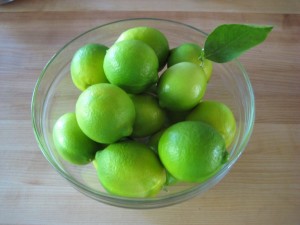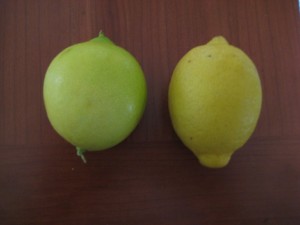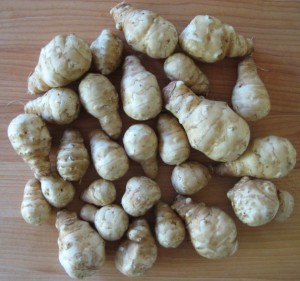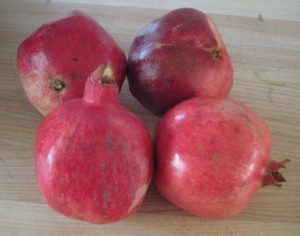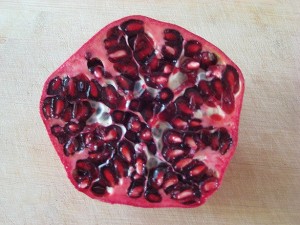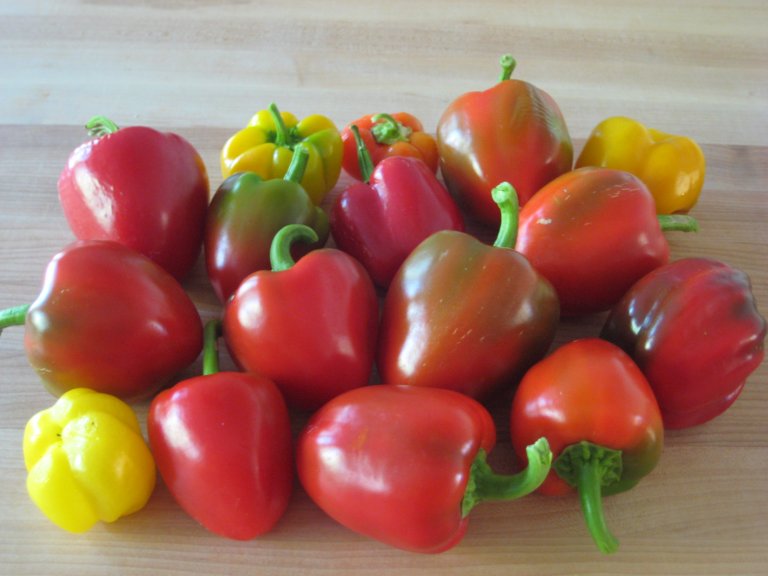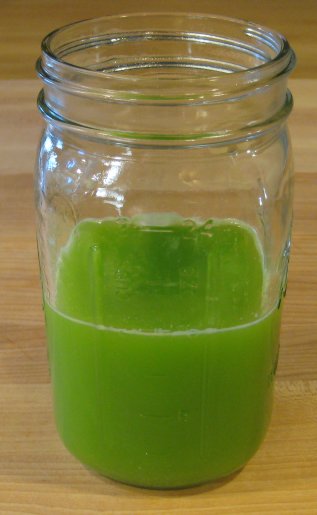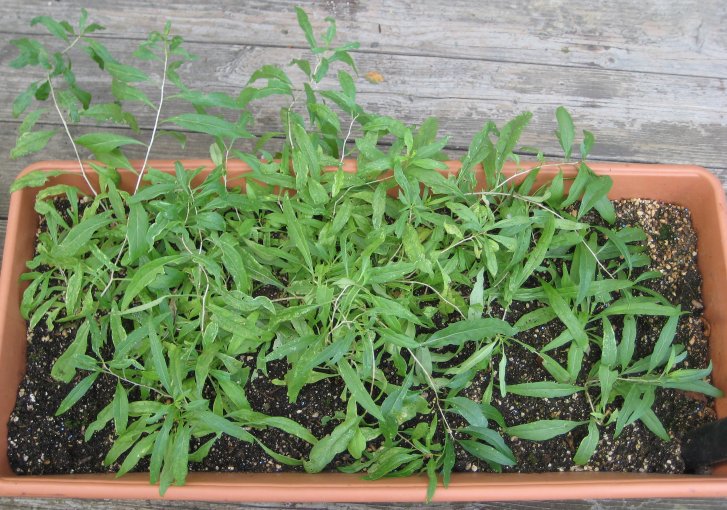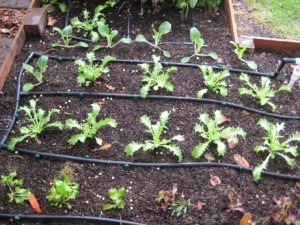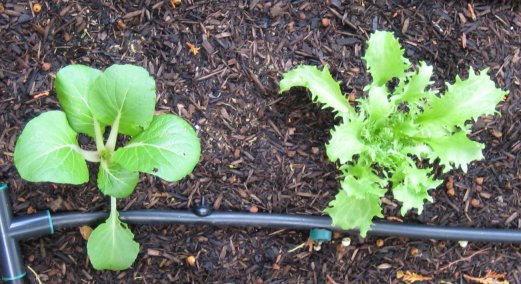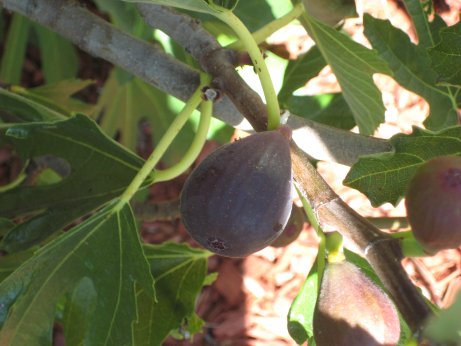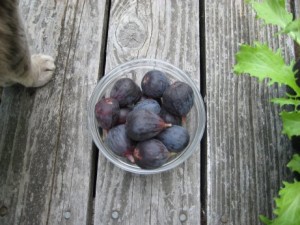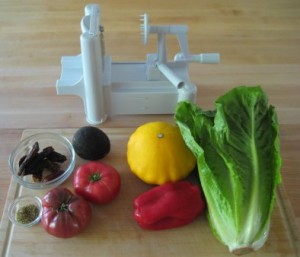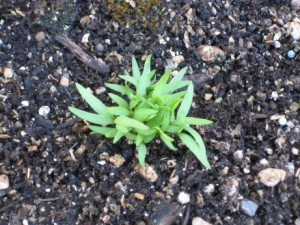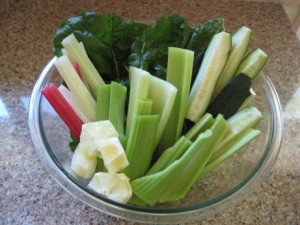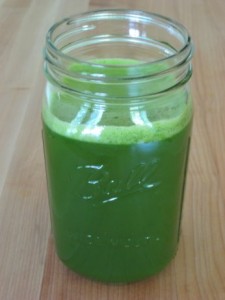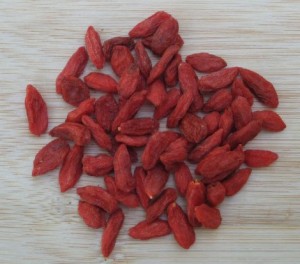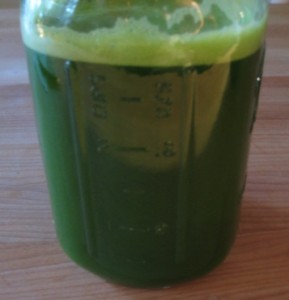 A couple of months ago, I posted a recipe for light green juice composed of celery, cucumber, and lemon. This recipe is a great introduction to green juice since it has a lemony flavor without the bitterness that green juice can have when certain dark leafy green vegetables are used to make the juice. I happen to love the flavor of most leafy greens, so here is a recipe for one of my favorite juices:
A couple of months ago, I posted a recipe for light green juice composed of celery, cucumber, and lemon. This recipe is a great introduction to green juice since it has a lemony flavor without the bitterness that green juice can have when certain dark leafy green vegetables are used to make the juice. I happen to love the flavor of most leafy greens, so here is a recipe for one of my favorite juices:
5 stalks of celery (12” long)
1 lemon, peeled
1 medium cucumber, 8” long
3 cups frisée greens
5 cups dandelion greens
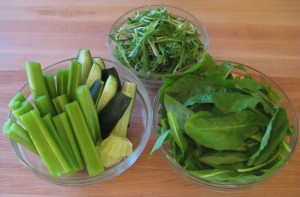
This recipe makes about 3 cups of juice. Here are some of the nutrients found in these ingredients:
| Dark Green Juice Ingredients | Adult Daily Values | |
| Calories | 270 | |
| Calcium | 790.3 | 1000 – 1200 mg |
| Iron | 11.8 | 8 – 18 mg |
| Zinc | 3.4 | 8 – 11 mg |
| Magnesium | 202.6 | 310 – 420 mg |
| Potassium | 2953.1 | 4700 mg |
As one can see, the dandelion greens and frisée greens contribute quite a bit of calcium and iron to this juice when compared to the light green juice recipe from October:
5 stalks of celery (12” long)
1 lemon, peeled
1 medium cucumber, 8” long
This recipe makes about 2 cups of juice. Here are some of the nutrients found in these ingredients:
| Light Green Juice Ingredients | Adult Daily Values | |
| Calories | 120.7 | |
| Calcium | 198.0 | 1000 – 1200 mg |
| Iron | 1.99 | 8 – 18 mg |
| Zinc | 1.07 | 8 – 11 mg |
| Magnesium | 81.05 | 310 – 420 mg |
| Potassium | 1390.39 | 4700 mg |
Dandelion greens and frisée greens are both members of the sunflower plant family (Asteraceae), cucumbers are in the squash family (Cucurbitaceae), celery is a member of the carrot family (Apiaceae), and lemons are in the citrus family (Rutaceae).
One of the best ways to keep in touch with us is to join our email list. You’ll receive a free copy of Our Top 12 Strategies for Long Term Success on A Raw Plant-Based Diet eBook along with regular information about raw food and plant-based diets and periodic promotions for our classes, events, and other offerings!
Welcome to 2012!
We hope that you had a joyful and healthy holiday season! January is always special time of the year for Rick and I. It is a time to rest, regroup, and set our sights on the coming year. It is also a time when we sit down and ask ourselves some formative questions: how have we progressed toward reaching our personal and professional goals and what do we want to achieve in the coming year.
Among many projects this year, we plan to continue our weekly blog posts on various health-related topics and would like to know what you want to see on this blog!
What nutrition and health topics are of interest to you? Are you interested in our travels, raw food science, our classes, and/or gardening? Are you interested in simply presented information or do you want to read about more technical topics such as nutritional biochemistry and physiology? Do you want to hear about the latest peer-reviewed nutrition research articles and clinical outcomes?
There are so many fascinating topics to share with you so we thank you for taking your time to post your questions and topics in the comment section below this blog post. We really appreciate your input!
Holiday Spices and Antioxidants
 Ah, the holidays! Ever since I was a young girl I looked forward to the month of December for its festivities and time spent with family and friends. When I started on my raw food journey in 1990, I designed raw alternatives of my favorite holiday dishes and desserts to share with my loved ones. I included one of my recipes in an earlier blog post – butternut squash pudding, which has become a new holiday tradition in my family.
Ah, the holidays! Ever since I was a young girl I looked forward to the month of December for its festivities and time spent with family and friends. When I started on my raw food journey in 1990, I designed raw alternatives of my favorite holiday dishes and desserts to share with my loved ones. I included one of my recipes in an earlier blog post – butternut squash pudding, which has become a new holiday tradition in my family.
Spices that are often used in holiday recipes have been studied for their antioxidant content. The antioxidant activity of the compounds found in spices and foods has been measured using a system called ORAC, or oxygen radical absorbance capacity. An ORAC value of a food is a measurement of the ability of antioxidants in the food to neutralize free radicals in vitro (in a test tube or laboratory). The ORAC measurement has been questioned by members of the scientific community because it is measured in vitro and not in living organisms (in vivo). A free radical is a molecule with an unpaired electron that can cause damage to cells in our body.
Much is currently known about nutrition, and there is much that we have yet to learn. Our scientific, clinical, and experiential knowledge about nutrition is incomplete and will continue to increase as our inquiry in this area progresses. I personally would be interested to see the ORAC values of foods measured in humans and other living beings (in vivo). Hopefully this information will be available sometime in the future.
Here is a sampling of holiday spices and their respective ORAC values:
| Total ORAC value (µmol TE/100 g) | |
| Cinnamon, ground | 131,420 |
| Cloves, ground | 290,283 |
| Ginger, ground | 39,041 |
| Nutmeg, ground | 69,640 |
I was amazed to see the high ORAC value of these spices, especially when compared to popular high ORAC value foods, such as:
| Blackberries | 5,905 |
| Blueberries | 4,669 |
| Wild blueberries | 9,621 |
| Raspberries | 5,065 |
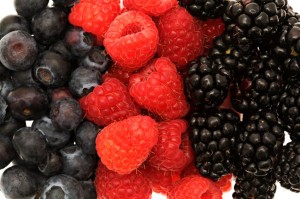
One might think, based on this information, that cinnamon, cloves, ginger, and nutmeg are superior sources of antioxidant activity to the fruits stated above. The spices are superior, PER 100 GRAMS. Please note that ORAC values for foods are reported per 100 grams.
But how much of each of these spices do we actually consume in a serving? Let’s do some simple calculations using ground cloves as an example. A typical 9” round pumpkin pie recipe calls for ¼ teaspoon of ground cloves. ¼ teaspoon of ground cloves weighs approximately 1 gram. The ORAC value for 100 grams of ground cloves is 290,283. If we divide this number by 100, we get a value of almost 2903 for 1 g of ground cloves in a whole pumpkin pie.
Now, there are generally 8 pieces in an average pumpkin pie. So, if we divide 2903 by 8 we get a value of about 363 for the 0.125 grams of ground cloves in one piece of pumpkin pie. Given that ORAC values are tested and reported per 100 grams of food, I cannot say that 363 is THE ORAC value for the 0.125 grams of ground cloves found in the piece of pie. I would need actual studies to confirm or deny this number, since other possible contributory factors must be taken into account. The bottom line here is that one needs to consider nutritional information, such as ORAC values, in the context of the amounts that one actually eats.
For comparison with another type of food, let’s consider the ORAC value and the amount of blackberries in one serving. The ORAC value for 100 g of blackberries is 5,905. One cup of blackberries weighs 144 g, so the ORAC value for 100 g of blackberries is very roughly equivalent to ⅔ of a cup, which could be considered a small serving of blackberries. Whenever I eat blackberries, I usually eat more than ⅔ cup, as do many raw food enthusiasts that I know.
Looking at the actual serving sizes of ground cloves and blackberries, one can strongly question the ORAC superiority of ground cloves to blackberries, or any of the other fruits shown in the table above. Of course, we would need more information on the antioxidant activity in the amount of cloves found in a piece of pumpkin pie to make a more definitive statement.
I would love to see researchers take into account such information when doing their studies, since this would make their information more meaningful and applicable to daily life. In the meantime, we must employ our skills of critical thinking when we hear such pieces of information out of context. Critical thinking is essential in many aspects of life, including the realm of nutrition information. We will address critical thinking in future blog posts.
For those of you interested in delving more deeply into this subject, here are some interesting points to note:
- The ORAC values reported are for dried and ground spices. I am curious to know if/how the ORAC value would differ in the fresh versions of these spices, especially ginger, since it is a naturally water-rich root.
- ORAC values are measured by weight, per 100 grams. I would like to see an ORAC value comparison per calorie, and as stated earlier, per serving size.
- If the food in question is part of a recipe or processed food, what other ingredients and/or processing methods can affect the ORAC value of that food?
For more information on the ORAC values of various foods, please visit: USDA nutrient database and USDA Database for the Oxygen Radical Absorbance Capacity (ORAC) of Selected Foods, Release 2 – May 2010
Best wishes for a happy and healthy new year!
One of the best ways to keep in touch with us is to join our email list. You’ll receive a free copy of Our Top 12 Strategies for Long Term Success on A Raw Plant-Based Diet eBook along with regular information about raw food and plant-based diets and periodic promotions for our classes, events, and other offerings!
December Limes
Last week, nighttime temperatures dropped into the low 30s in our area of northern California. It is rare to have freezing temperatures here, so when the outside temperature nears 32º F, residents of this area do their best to keep their freeze-sensitive plants warm. A good example of such plants would be citrus, including limes. I love the tangy flavor of limes. One of our neighbors has several citrus plants, including limes, so I was thrilled when our very generous neighbor came over with a basket filled with limes for us. Here is a picture of some of them:
Limes are famous for their green color, which actually changes to a more yellow color as they ripen. Limes have that fabulous tangy flavor when they are still green, which tends to mellow somewhat as they ripen. Our neighbor harvested these limes when they had not fully ripened to keep them from being harmed by the cold weather.
Limes are well known for their vitamin C content, as are lemons and oranges and other members of the citrus family. I was surprised to see the calcium and iron content of limes, which per calorie, is notable.
Here are some of the nutrition highlights of limes:
| 3 peeled limes | |
| Calories | 60 |
| Vitamin C | 58.5 mg |
| Calcium | 66 mg |
| Iron | 1.21 mg |
For comparison purposes, here are some of the nutrition highlights of lemons:
| 3 peeled lemons | |
| Calories | 50 |
| Vitamin C | 92.2 mg |
| Calcium | 45 mg |
| Iron | 1.04 mg |
Per calorie, lemons have more vitamin C, limes have more calcium, and both have a similar amount of iron.
Here is a photo of an almost-ripe lime (left) and lemon (right) placed on a dark red background for contrast:
Best of health!
Dr. Karin Dina, D.C.
A Surprising Source of Iron
Once in a while, I come across a nutrient dense food that is not popularly known for its nutrient content. Recently when doing some research on plant sources of iron, I found Jerusalem artichokes. This interesting root (or more specifically, tuber) is a member of the sunflower family plant family, along with lettuce, dandelion greens, yacón, and of course, sunflower seeds.
Last spring, a friend encouraged us to grow Jerusalem artichokes in our backyard garden. Given that they have a tendency to spread wherever they are planted, we planted them in a compost/soil mixture in a barrel planter on our backyard deck. We are happy to report that our cultivation efforts were successful and have recently harvested numerous Jerusalem artichokes. Here is a sampling of our harvest:
The best way that I can describe the taste of Jerusalem artichokes is mildly sweet, similar to yacón root and jicama. As far as nutrient content is concerned, I was impressed to see the iron content of 1 cup of Jerusalem artichoke slices:
| 1 cup sliced Jerusalem artichoke (150 g) | Adult Daily Values | |
| Calories | 110 | |
| Vitamin B3 (Niacin) | 1.93 mg | 14 – 16 mg |
| Iron | 5 mg | 8 – 18 mg |
| Potassium | 643 mg | 4700 mg |
One of the best ways to keep in touch with us is to join our email list. You’ll receive a free copy of Our Top 12 Strategies for Long Term Success on A Raw Plant-Based Diet eBook along with regular information about raw food and plant-based diets and periodic promotions for our classes, events, and other offerings!
Ultra simple raw food recipe for butternut squash pudding
‘Tis the season to be festive, so Rick and I thought we would share one of our favorite holiday recipes with you! We have always loved pumpkin pie, so this recipe is a raw, whole food sweetened version of the filling for the traditional favorite.

A very popular question that we are asked is “what type of sweetener do you use?” We very rarely use sweeteners in our recipes, but when we do use a sweetener, it is dates. There many possible alternative sweeteners which each may be more appropriate for specific recipes, but we prefer to use dates because they are a whole food and we enjoy the taste. We also consider simplicity and nutrient content when developing our recipes.
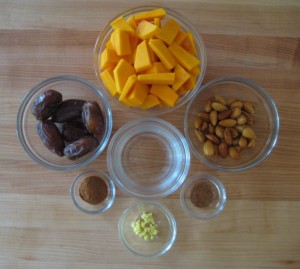
Here is the recipe, which makes 24 ounces or four 6-ounce servings:
- 2 Cups peeled fresh butternut squash
- 6 Medjool dates or ¾ cup of other type of dates
- ⅓ Cup soaked raw almonds (best if soaked for at least 8 hours prior to making recipe)
- ½ Cup good quality water (more may be necessary)
- 1 Tsp. ground cinnamon
- ½ Tsp. chopped fresh ginger
- ¼ Tsp. ground nutmeg
This recipe can also be used as filling for a raw pie, or one can substitute 2 cups of chopped pumpkin for the butternut squash if desired. Just remember to use pie pumpkin, which we have found to be more flavorful than the Jack-o-lantern type. 🙂
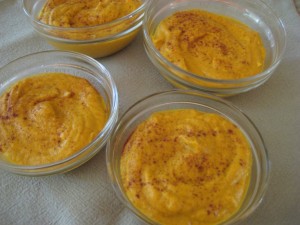
Here is how we prepare this recipe:
- Add ½ cup water to high powered blender, followed by spices and dates
- Blend until ingredients are reasonably homogenous
- Add ½ cup of butternut squash to mixture and blend, then add ½ cup of squash and blend, continue this process until all squash is blended with the mixture
- We often add some extra water during this process, if the mixture is too thick
- Add soaked almonds to the mixture and blend until mixture is completely smooth
- Pour into dessert glasses and sprinkle a pinch of ground cinnamon on top
- Chill and enjoy!
Have a Happy Thanks Living!
One of the best ways to keep in touch with us is to join our email list. You’ll receive a free copy of Our Top 12 Strategies for Long Term Success on A Raw Plant-Based Diet eBook along with regular information about raw food and plant-based diets and periodic promotions for our classes, events, and other offerings!
What I learned from pomegranates
A tongue-in-cheek antidote to all of the complicated research that I read:
Pomegranates were, at one time, a fruit that I did not understand. Being from the northeast, I had never seen anyone eat one, but this did not deter my curiosity about them.
Back in the pre-internet era, the first time I attempted to eat a pomegranate, I tried to peel off the tough outer skin only to find more tough fiber on the inside interspersed with pockets of numerous seeds each surrounded by a small, delicate, dark red fluid-filled pouch that promptly burst as I tried to remove them. They are called arils.
My wood cutting board was stained a lovely shade of magenta for days after this attempt.
When I moved to northern California, I would regularly see pomegranates at the local farmer’s market and in produce departments of natural food stores during the months of November and December. I would hear from friends and students about how delicious pomegranates taste, but it was only recently when I was researching the antioxidant content of pomegranates, that I decided to revisit this fascinating fruit.
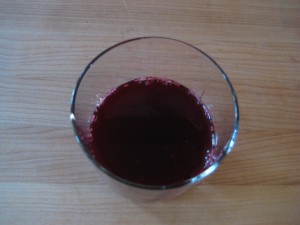
Not surprisingly, many people I know who consume pomegranates do so in the form of juice. Which raises the question: how does one juice pomegranates? I tried several juicing methods that were available in my kitchen and found that the use of a handheld citrus juicer was easiest and cleanest for me.
Here is what I did:
I cut a couple of pomegranates into quarters, placed the pomegranate quarters into the citrus squeezer one at a time, and squeezed the citrus squeezer into a large glass bowl. Out came the juice with relatively little effort and mess! So simple! And the juice was delicious - similar to cranberry juice but a lot sweeter. Both Rick and I loved it.
So, here is what I learned from this experience:
- Pomegranates do not peel like an orange. 🙂
- Using a nice bamboo or wood cutting board will very likely end in stains. Hmmmm….
- My answer to pomegranate preparation was simple. This makes me wonder what other issues that can seem complicated at first may have simple answers once one educates oneself. 🙂
What simple answers are you overlooking in your life?
Has anyone juiced pomegranates with a citrus press?
One of the best ways to keep in touch with us is to join our email list. You’ll receive a free copy of Our Top 12 Strategies for Long Term Success on A Raw Plant-Based Diet eBook along with regular information about raw food and plant-based diets and periodic promotions for our classes, events, and other offerings!
Early November Red Bell Peppers
This is the first year that we attempted to grow bell peppers in our garden. A friend, who is a gardener extraordinaire, came over this spring to help us build a small raised bed for our first pepper crop. Throughout the summer we watched the plants grow, flower, and then bear small fruits. The small fruits grew slowly and gradually started to change color from green to red, with some shade of brown in between. As you can see from the photo below, some turned yellow! As November neared, we wondered if the numerous peppers would fully ripen before the weather became too cold.
Last week, almost overnight, a large percentage of the peppers turned almost completely red. We were excited, so we picked a couple and enjoyed them in our salad dressing that night. We sampled the peppers and found that they were some of the most flavorful red bells that we had ever tasted. There is no doubt that home grown vegetables tend to be incredibly flavorful, especially in comparison to their store-bought counterparts. These bell peppers were certainly no exception, but rather, exceptional.
Red bell peppers are well known for their vitamin C and beta-carotene content.
Here are some of the nutrition highlights of red bell peppers:
| One cup chopped red bell pepper | |
| Calories | 46.2 |
| Vitamin C | 190.3 mg |
| Beta-carotene | 2419.8 mcg |
I also looked up the nutrient content of green bell peppers for comparison:
| One cup chopped green bell pepper | |
| Calories | 29.8 |
| Vitamin C | 119.8 mg |
| Beta-carotene | 309.9 mcg |
Per calorie, the vitamin C content of red and green bell peppers appears to be similar, at least for the samples compared. Beta-carotene content, however, is much higher per calorie in red bell peppers than green. Ripeness appears to make a difference in this case.
One of the best ways to keep in touch with us is to join our email list. You’ll receive a free copy of Our Top 12 Strategies for Long Term Success on A Raw Plant-Based Diet eBook along with regular information about raw food and plant-based diets and periodic promotions for our classes, events, and other offerings!
Light Green Juice
A family member recently asked me about green juice, and expressed an interest in recipes and tips for making it tasty. I LOVE green juice and have many recipes that I enjoy, which I am happy to share. There is one challenge, this family member does not like the taste of dark leafy greens: raw, steamed, juiced, in a green smoothie, etc. This is by no means unusual, since I have met many people over the years that are turned off by the taste of greens, especially when they are new to healthy eating.
I can understand that the strong taste of such greens is often an acquired taste, and may take some “getting used to”. Since this loved one is just getting started with juicing, I shared a recipe for “light” green juice with milder-tasting ingredients, such as celery, lemon, and cucumber. This is actually the base juice that I use for my green juices with more ingredients. Here is the recipe:
5 stalks of celery (12” long)
1 lemon, peeled
1 medium cucumber, 8” long
This recipe makes about 2 cups of juice. Here are some of the nutrients found in these ingredients:
| Light Green Juice ingredients | Adult Daily Values | |
| Calories | 120.7 | |
| Calcium | 198.0 | 1000 – 1200 mg |
| Iron | 1.99 | 8 – 18 mg |
| Zinc | 1.07 | 8 – 11 mg |
| Magnesium | 81.05 | 310 – 420 mg |
| Potassium | 1390.39 | 4700 mg |
I love the lemony taste, but there is much one can do with green juice – the sky is most certainly the limit. I have sampled many creative and delicious green juices over the years. This one is quick and easy to make, I spend about 20 minutes from start to finish, including set up and clean up time!
One of the best ways to keep in touch with us is to join our email list. You’ll receive a free copy of Our Top 12 Strategies for Long Term Success on A Raw Plant-Based Diet eBook along with regular information about raw food and plant-based diets and periodic promotions for our classes, events, and other offerings!
Goji Berry Plants – 4 Months Old
Our goji plants have grown quite a bit since we planted the seeds in June – it's time for transplanting 🙂
One of the best ways to keep in touch with us is to join our email list. You’ll receive a free copy of Our Top 12 Strategies for Long Term Success on A Raw Plant-Based Diet eBook along with regular information about raw food and plant-based diets and periodic promotions for our classes, events, and other offerings!
Fall Garden Greens
Here in northern California, many different types of foods can grow throughout the fall, winter, and spring, especially greens. Right now, some of our summer crops are still producing, such as heirloom tomatoes, bell peppers, and summer squash, which are doing well despite the rain and cool night temperatures we have been experiencing lately. We do have space in our garden for fall plants, so last week, I went to a local farmer’s market, and purchased some plant starts, including red and green leaf lettuce, bok choy, and frisée greens. Here is a picture of these plants now growing in our garden:
This Sunday, we returned from a weekend out of town teaching our Science of Raw Food Nutrition I class (it was fun, as always!) to find that our starts had almost doubled in size! Right now, it appears that the frisée greens have the lead over the bok choy and lettuce, but later in the season we will see which of our greens will be the ultimate champion size-wise.
Nutritionally speaking, all of these plants have their attributes. Bok choy is often praised for its mineral content, but what about much less heard-of frisée greens?
Here are some nutrient highlights of frisée greens:
| 3 cups chopped frisée greens (150 g) | Adult Daily Values | |
| Calories | 25.5 | |
| Calcium | 78 mg | 1000 – 1200 mg |
| Iron | 1.24 mg | 8 – 18 mg |
| Zinc | 1.18 mg | 8 – 11 mg |
Young bok choy and frisée greens:
One of the best ways to keep in touch with us is to join our email list. You’ll receive a free copy of Our Top 12 Strategies for Long Term Success on A Raw Plant-Based Diet eBook along with regular information about raw food and plant-based diets and periodic promotions for our classes, events, and other offerings!
Early October Figs
I love October. There are so many things to love about this beautiful month, such as the fall foliage, crispness of the air, leaf piles (dare I jump in? :)), pumpkins, the availability of certain fresh foods that are challenging to find at other times of the year, and the list goes on. One of the foods available now in northern California is fresh figs, such as those ripening on a tree in our front yard.
Before I moved to California, I thought of figs as strange looking dried fruits found in a bulk bin at my local health food store. When I first tried fresh figs, I found that the flavor and texture were quite different from the dried version. I do enjoy dried figs, and eat them from time to time, but I really enjoy fresh figs. People have asked me if I have any good fresh fig recipes – sorry, I do not. The reason why is because figs tend to disappear rather quickly in my house. 🙂
How long will these figs last in our house? Get out the stopwatch…..
The first time I saw a nutrient analysis of figs, I was amazed at the calcium and iron content, which is higher than most fruits per calorie. Potassium content is notable, too. Here are some nutrition highlights of figs:
| 6 medium figs (300 g) | Adult Daily Values | |
| Calories | 222 | |
| Calcium | 105 mg | 1000 – 1200 mg |
| Iron | 1.11 mg | 8 – 18 mg |
| Potassium | 696 mg | 4700 mg |
One of the best ways to keep in touch with us is to join our email list. You’ll receive a free copy of Our Top 12 Strategies for Long Term Success on A Raw Plant-Based Diet eBook along with regular information about raw food and plant-based diets and periodic promotions for our classes, events, and other offerings!
Raw food recipe for heirloom tomato marinara sauce and summer squash noodles
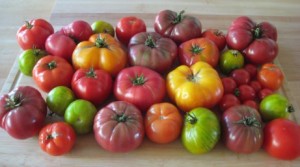 Last night, Rick and I had a couple of friends over for dinner to share in our heirloom tomato harvest. 🙂 We made spiralized squash with some sunburst squash from the garden and a marinara sauce from garden tomatoes, sundried tomatoes and some other simple ingredients:
Last night, Rick and I had a couple of friends over for dinner to share in our heirloom tomato harvest. 🙂 We made spiralized squash with some sunburst squash from the garden and a marinara sauce from garden tomatoes, sundried tomatoes and some other simple ingredients:
Marinara Sauce (one serving)
2 medium fresh tomatoes (2 cups chopped)
6 soaked sun dried tomatoes (1 ounce dry or 28.3 g)
½ tsp. dried oregano or other Italian spices
1 medjool or other type of date
¼ ripe avocado or one tablespoon of chia seeds
We blended the fresh tomatoes, spices, date, and avocado in a high powered blender, then added soaked sundried tomatoes and blended until smooth. For a lower fat recipe, one could leave out the avocado or chia seeds. For garlic lovers, one could add ¼ clove of fresh garlic. We used heirloom tomatoes from our garden for this recipe, but popular red varieties would work well too.
To make squash pasta, we used a vegetable spiralizer. The resultant “noodles” had the consistency of linguine al dente, since the squash used was mature – we let some of the summer squash in our garden get a little too big this year.
In general, for spiralizing, we like to use squash or zucchini that is younger in order to create softer noodles. We added the noodles to a bed of romaine lettuce mixed with chopped red bell pepper:
Summer squash pasta and salad (one serving)
4 cups spiralized yellow summer squash served on a bed of 4 cups of lettuce mixed with 1 cup of chopped red bell pepper.
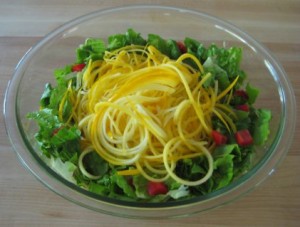 Here are some nutrients in the sauce, pasta, and salad:
Here are some nutrients in the sauce, pasta, and salad:
| Recipes | Adult Daily Values | |
| Calcium | 245 | 1000 – 1200 mg |
| Iron | 8.4 | 8 – 18 mg |
| Magnesium | 239 | 310 – 420 mg |
| Potassium | 4125 | 4700 mg |
| Zinc | 3.7 | 8 – 11 mg |
Here is a picture of the final dish:
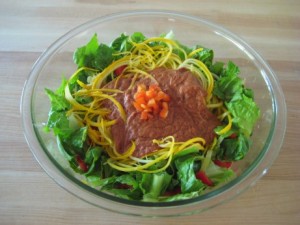
It was sooooo good 🙂
One of the best ways to keep in touch with us is to join our email list. You’ll receive a free copy of Our Top 12 Strategies for Long Term Success on A Raw Plant-Based Diet eBook along with regular information about raw food and plant-based diets and periodic promotions for our classes, events, and other offerings!
September Blackberries
Today was an especially hot day (over 90º F) in Sonoma County and aside from the leaves on the maple tree in my front yard turning red, one would hardly guess that autumn is upon us. One of the many things that I love about northern California is late summer blackberries. Even though these beautiful and tasty berries are available throughout the summer and into the fall, I love berry picking in September since a number of the berries on a given bush are ripe and practically fall into my hands as I pick them. My favorite blackberry bush is located in a park close to my house where I find myself checking on the progress of the berries from time to time during the summer months when I pass by while out on a run or walk.
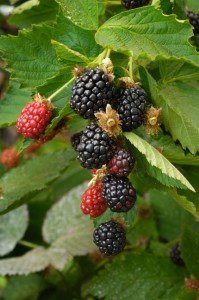
Today, I picked some to enjoy in a green smoothie. Here are some nutrient highlights of blackberries:
One cup (144 grams) of blackberries contains 62 calories, 33% of the daily value (DV) for vitamin C, 4% of the DV for calcium, 5% of the DV for iron, 7% of the DV for magnesium, 5% of the DV for potassium, 7% of the DV for zinc. One cup of blackberries also contains 184 mcg of beta carotene and 170 mcg of lutein and zeaxanthin. Blackberries have been studied for their antioxidant content, including anthocyanins which may lend a red, purple or blue color to various fruits and vegetables, such as blueberries and raspberries.

Given that one cup of blackberries contains 62 calories, which is 3% of the calories consumed on a 2,000 calorie diet, blackberries contain reasonable percentages of the important nutrients mentioned above.
Source for nutrient information on blackberries: USDA nutrient database
One of the best ways to keep in touch with us is to join our email list. You’ll receive a free copy of Our Top 12 Strategies for Long Term Success on A Raw Plant-Based Diet eBook along with regular information about raw food and plant-based diets and periodic promotions for our classes, events, and other offerings!
Growing goji berry plants – Update
Rick and I returned home from a long weekend out of town to find that our goji seeds had germinated! We are so excited! Here is a photo of two growing together.
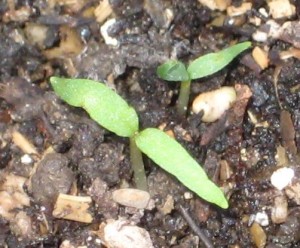
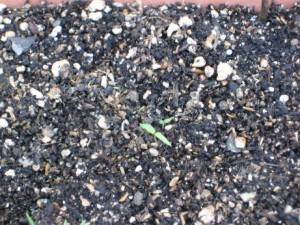
Here is a group of very young goji plants growing together. I planted a whole berry here and it appears that many of the goji seeds germinated.
Our next task is to thin the plants so each can have more space to grow. We’ll keep you updated on their progress. 🙂
One of the best ways to keep in touch with us is to join our email list. You’ll receive a free copy of Our Top 12 Strategies for Long Term Success on A Raw Plant-Based Diet eBook along with regular information about raw food and plant-based diets and periodic promotions for our classes, events, and other offerings!
A Variation on My Favorite Green Juice
Several months ago, I was at my local farmer’s market and saw some Swiss chard starts for sale from a local garden plant vendor. I have never grown chard before, so I thought it would be fun to give it a try. Well, now Rick and I have LOTS of chard growing in our garden and have the opportunity to use it in different recipes. Yesterday, I had a couple of
chard leaves in my morning smoothie and today I thought I would try it in a green juice.
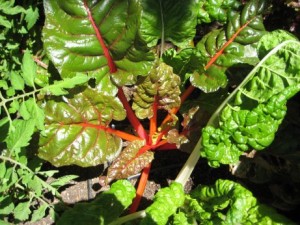
My favorite green juice recipe contains celery, cucumber, the juice of one lemon, and some type of leafy green. For the green, I like to use either kale or dandelion greens, but since I have fresh chard from the garden I used 3 leaves of it in my juice.
Here are the ingredients of the juice: four stalks of celery, one large cucumber, one peeled lemon, and 3 leaves of Swiss chard. I used our twin gear juicer to make the juice and it was really good! I really love the tart lemon taste. One can add apple or some other fruit for a sweet taste, or leave out the lemon for a “green” taste.
A nutrition note: Raw Swiss chard is NOT a rich source of calcium, due to its high oxalic acid content. I do not rely on it as a source of calcium, nor do I make juice out of it often. Swiss chard is in the goosefoot plant family, the same family as spinach and other foods that are high in oxalic acid.
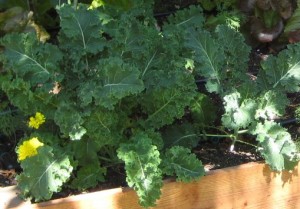
Leafy greens that are lower in oxalic acid include cabbage family plants such as kale and bok choy. There are plenty of plant food sources of calcium that we cover in our course the Science of Raw Food Nutrition Level I and will cover in future blog posts.
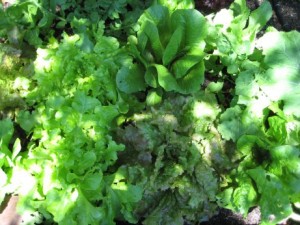
Some non-cabbage family leafy vegetables that I enjoy in salads include dandelion greens, endive, escarole, frisée greens (curly endive), and lettuce, of course. We’ll leave my salad contents for a future post. 🙂
Growing goji berry plants
At the time, I had never before seen an actual goji plant growing in a garden, given that goji berries are native to Asia and are not popularly cultivated as a garden crop here in the United States. Not surprisingly, the berries on the plant reminded me of tiny Roma tomatoes, given that goji berries (lycium barbarum) are in the nightshade plant family (Solanaceae), the same plant family as tomatoes, potatoes, bell peppers, eggplant, and Incan berries (a.k.a. golden berries).
I was excited to find after doing a little research that goji plants can grow in the area where Rick and I live. I am a big fan of locally grown food, so I thought it would be fun to grow some goji berry plants in my backyard garden.
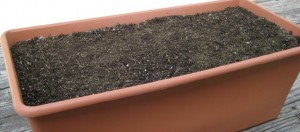
Today, I looked for a suitable container in which to grow my goji seeds. I found an unused planter, filled it with soil, and made ½ inch deep holes about 2 inches apart. I opened several goji berries to find 20+ tiny seeds in each, which I carefully removed and did my best to place one seed in each of the holes. In several of the holes, I placed a single goji berry to see if multiple seeds would germinate together. I filled in the holes with soil and then watered the planted seeds and soil.
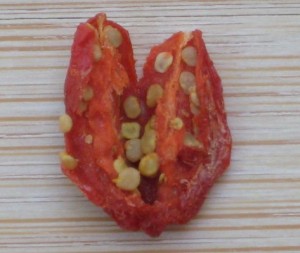
Now that the seeds are planted, I am looking forward to seeing how many, if any, actually germinate and produce plants. I’ll give you updates as the growing season progresses. 🙂
We are happy to announce….
our first blog post! We are looking forward to writing about various topics that inspire us and have helped us achieve our personal health goals.
As expected, we will be writing about fresh whole natural plant foods from a scientific/ research perspective in a relatable and fun manner. Our goal is to regularly cover topics that you find to be valuable, so our question to you is: what health and nutrition subjects would you like to read on our blog? Please let us know by writing your suggestions in the comment section below.
Yours in health,
Drs. Karin and Rick Dina, D.C.
One of the best ways to keep in touch with us is to join our email list. We send out monthly newsletters, notifications of our speaking engagements, and more:


